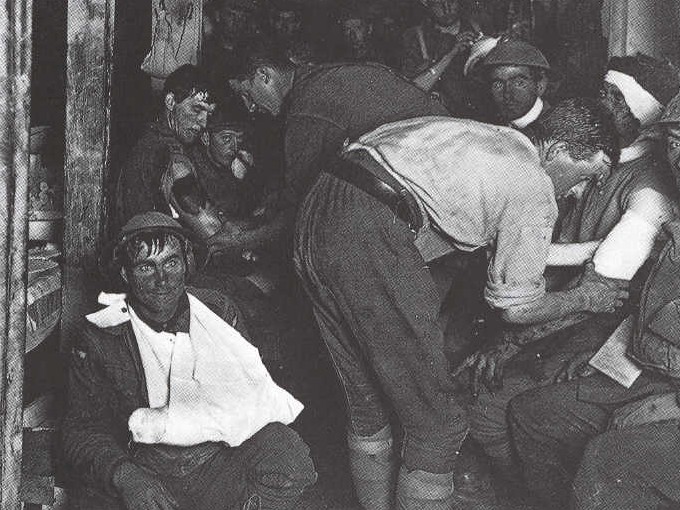
I'm on way to Mendinghem
With a ticket home to Blighty
Why did they send us over here
Oh Jesus Christ Almighty
Lester Simpson
The First World War made greater demands on the medical services of all the nations involved than another previous conflict. The BEF in France and Belgium alone suffered 2,690,054 battle casualties throughout the campaign, of these 677,515 were killed or died of wounds. Just over 12% of the total number of British soldiers who served on the Western Front were killed or died, and nearly 38% were wounded. Consequently the Royal Army Medical Corps grew from less than 20,000 men in August 1914 to over 140,00 by November 1918.
For those who became casualties to first link in the treatment chain, were the regimental stretcher bearers, whose task it was to collect the seriously wounded from No Man's Land and take them to a regiment aid post.
Regimental Aid Post - commanded by a regiment Medical Officer and a senior Royal Army Medical Corps NCO. These posts would be near the support lines. The condition of the wounded man would be assessed and logged. If the wound was deemed non-debilitating he would be classified as "walking-wounded" and dispatched to one of the Divisional Collecting Post. Stretcher cases were removed to to the nearest Advanced Dressing Stations.
Advanced Dressing Stations - commanded by a Royal Army Medical Corps Captain and orderlies. These were normally sited behind the front lines in a suitable building or dugout. Here the casualty would be thoroughly examined and in emergency cases operated on. After appropriated treatment and logged the wounded were transported to Main Dressing Stations. Examples of which were at Bedford House and Belgium Battery Corner.

Australian Advanced Dressing Station near Ypres (20th Sept. 1917).
Main Dressing Stations - commanded by Royal Army Medical Corps Major. Situated up to 3 miles behind the Advanced Dressing Stations, based in huts or large tents. It was here that treatment began in ernest, wounds were treated and those who injuries were serious were dispatched to Field Hospital made up of several Casualty Clearing Stations. Examples of which were at Gwalia
Field Hospitals - commanded by Royal Army Medical Corps Lieut. Col with a staff of specialist surgeons, physicians and nurses. It was here that the badly wounded received attention. Examples of which were at Brandhoek and Liijssenthoek. After some time the Field Hospitals began to specialise in different types or wounds, ailments and conditions, thereby further improving survival rate.
Those casualties deemed beyond treatment of the Field Hospitals were taken to Base Hospitals, these were based at places like Calias, Boulonge and England.